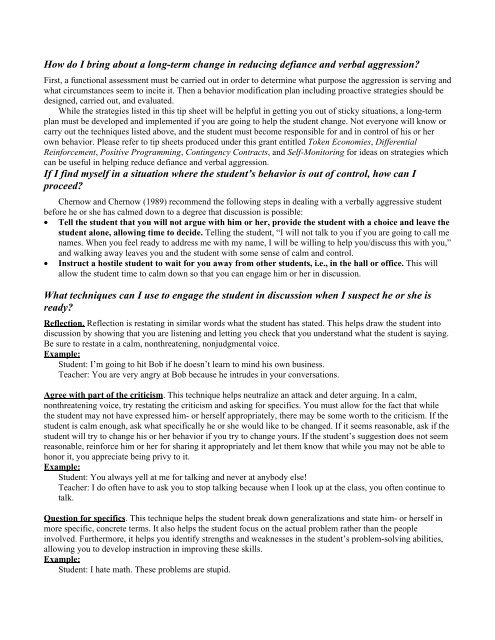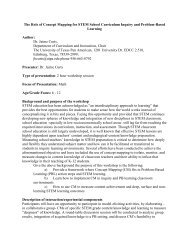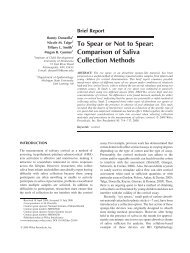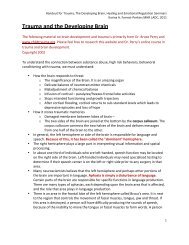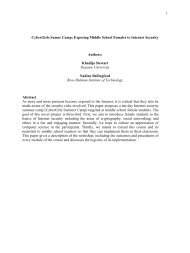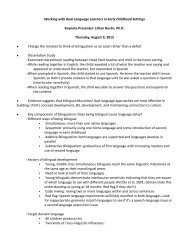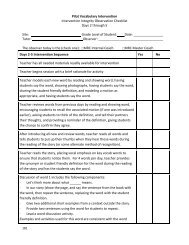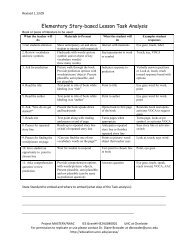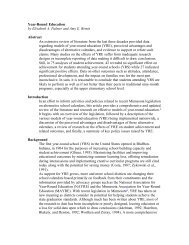Introduction to Positive Ways of Intervening with Challenging Behavior
Introduction to Positive Ways of Intervening with Challenging Behavior
Introduction to Positive Ways of Intervening with Challenging Behavior
You also want an ePaper? Increase the reach of your titles
YUMPU automatically turns print PDFs into web optimized ePapers that Google loves.
How do I bring about a long-term change in reducing defiance and verbal aggression?<br />
First, a functional assessment must be carried out in order <strong>to</strong> determine what purpose the aggression is serving and<br />
what circumstances seem <strong>to</strong> incite it. Then a behavior modification plan including proactive strategies should be<br />
designed, carried out, and evaluated.<br />
While the strategies listed in this tip sheet will be helpful in getting you out <strong>of</strong> sticky situations, a long-term<br />
plan must be developed and implemented if you are going <strong>to</strong> help the student change. Not everyone will know or<br />
carry out the techniques listed above, and the student must become responsible for and in control <strong>of</strong> his or her<br />
own behavior. Please refer <strong>to</strong> tip sheets produced under this grant entitled Token Economies, Differential<br />
Reinforcement, <strong>Positive</strong> Programming, Contingency Contracts, and Self-Moni<strong>to</strong>ring for ideas on strategies which<br />
can be useful in helping reduce defiance and verbal aggression.<br />
If I find myself in a situation where the student’s behavior is out <strong>of</strong> control, how can I<br />
proceed?<br />
Chernow and Chernow (1989) recommend the following steps in dealing <strong>with</strong> a verbally aggressive student<br />
before he or she has calmed down <strong>to</strong> a degree that discussion is possible:<br />
• Tell the student that you will not argue <strong>with</strong> him or her, provide the student <strong>with</strong> a choice and leave the<br />
student alone, allowing time <strong>to</strong> decide. Telling the student, “I will not talk <strong>to</strong> you if you are going <strong>to</strong> call me<br />
names. When you feel ready <strong>to</strong> address me <strong>with</strong> my name, I will be willing <strong>to</strong> help you/discuss this <strong>with</strong> you,”<br />
and walking away leaves you and the student <strong>with</strong> some sense <strong>of</strong> calm and control.<br />
• Instruct a hostile student <strong>to</strong> wait for you away from other students, i.e., in the hall or <strong>of</strong>fice. This will<br />
allow the student time <strong>to</strong> calm down so that you can engage him or her in discussion.<br />
What techniques can I use <strong>to</strong> engage the student in discussion when I suspect he or she is<br />
ready?<br />
Reflection. Reflection is restating in similar words what the student has stated. This helps draw the student in<strong>to</strong><br />
discussion by showing that you are listening and letting you check that you understand what the student is saying.<br />
Be sure <strong>to</strong> restate in a calm, nonthreatening, nonjudgmental voice.<br />
Example:<br />
Student: I’m going <strong>to</strong> hit Bob if he doesn’t learn <strong>to</strong> mind his own business.<br />
Teacher: You are very angry at Bob because he intrudes in your conversations.<br />
Agree <strong>with</strong> part <strong>of</strong> the criticism. This technique helps neutralize an attack and deter arguing. In a calm,<br />
nonthreatening voice, try restating the criticism and asking for specifics. You must allow for the fact that while<br />
the student may not have expressed him- or herself appropriately, there may be some worth <strong>to</strong> the criticism. If the<br />
student is calm enough, ask what specifically he or she would like <strong>to</strong> be changed. If it seems reasonable, ask if the<br />
student will try <strong>to</strong> change his or her behavior if you try <strong>to</strong> change yours. If the student’s suggestion does not seem<br />
reasonable, reinforce him or her for sharing it appropriately and let them know that while you may not be able <strong>to</strong><br />
honor it, you appreciate being privy <strong>to</strong> it.<br />
Example:<br />
Student: You always yell at me for talking and never at anybody else!<br />
Teacher: I do <strong>of</strong>ten have <strong>to</strong> ask you <strong>to</strong> s<strong>to</strong>p talking because when I look up at the class, you <strong>of</strong>ten continue <strong>to</strong><br />
talk.<br />
Question for specifics. This technique helps the student break down generalizations and state him- or herself in<br />
more specific, concrete terms. It also helps the student focus on the actual problem rather than the people<br />
involved. Furthermore, it helps you identify strengths and weaknesses in the student’s problem-solving abilities,<br />
allowing you <strong>to</strong> develop instruction in improving these skills.<br />
Example:<br />
Student: I hate math. These problems are stupid.


